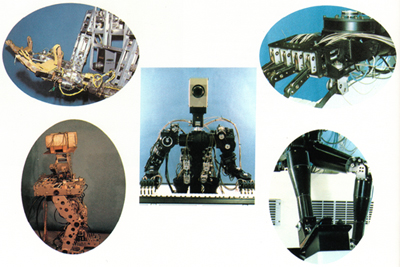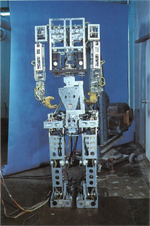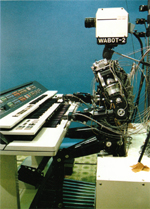 |
 
WABOT -WAseda roBOT-
It has been forecast that robots will penetrate society in
21st century not only in secondary industry but also in the service industry,
that is, the tertiary industry field. In that case, robots will be required
to have anthropomorphic appearance sand faculties. In another words, since
the robots that play active roles in the secondary industry are assessed
as substitutions of human labor power, the robots being developed for
the future should have an ability to deal with information as well as
a person does. Developing the anthropomorphic intelligent robot WABOT
(WAseda roBOT) was then started aiming to finally develop a "personal
robot" which resembled a person as much as possible.
Four laboratories in the School of Science & Engineering of
Waseda University joined to set up "The Bio-engineering group" which started
the WABOT project in 1970. Our laboratory has taken charge of the limb-control
system in the WABOT, which consists of the artificial limbs and their
control system.
| |
 |
|

WABOT-1
(1973)
|
|
WABOT-1 (1970~1973)
The WABOT-1 was the first fun-scale anthropomorphic robot developed
in the world. It consisted of a limb-control system, a vision system
and a conversation system. The WABOT-1 was able to communicate-with
a person in Japanese and to measure distances and directions to the
objects using external receptors, artificial ears and eyes, and an
artificial mouth. The WABOT-1 walked with his lower limbs and was
able to grip and transport objects with hands that used tactile-sensors.
It was estimated that the WABOT-1 has the mental faculty of a one-and-half-year-old
child. WABOT-1 consisted of the WAM-4 (as its artificial hands) and
the WL-5 (Its artificial legs). |
|
 WABOT-2 (1984)
WABOT-2 (1984)
|
|
WABOT-2 (1980~1984)
In 1980, our laboratories joined in a joint project again and commenced
the WABOT-2 project. Playing a keyboard instrument was set up as
an intelligent task that the WABOT-2 aimed to accomplish, since
an artistic activity such as playing a keyboard instrument would
require human-like intelligence and dexterity. Therefore the WABOT-2
was defined as a "specialist robot" rather than a versatile robot
like the WABOT-1.
The robot musician WABOT-2 can converse with a person, read a normal
musical score with is eye and play tunes of average difficulty on
an electronic organ. The WABOT-2 is also able of accompanying a
person while he listens to the person singing. The WABOT-2 was the
first milestone in developing a "personal robot".
|
[Next] [Content Top]
Copyright by Humanoid Robotics Institute, Waseda University. All rights
reserved.
|